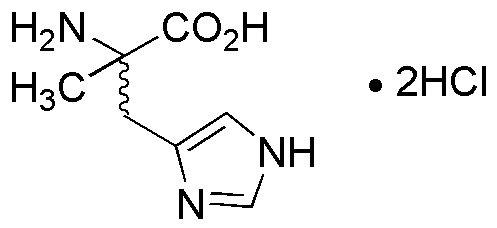DL-a-Methylhistidine dihydrochloride is widely utilized in research focused on:
- Biochemical Research: This compound serves as a valuable tool in studying protein synthesis and muscle metabolism, particularly in understanding the role of histidine in muscle function.
- Pharmaceutical Development: It is used in the formulation of drugs aimed at enhancing muscle recovery and growth, making it significant in sports medicine and rehabilitation.
- Nutrition Science: Researchers explore its effects on dietary supplements, particularly for athletes seeking to improve performance and reduce fatigue.
- Clinical Studies: The compound is involved in clinical trials assessing its potential benefits in treating conditions related to muscle wasting and metabolic disorders.
- Analytical Chemistry: It is utilized in various assays and analytical methods to quantify histidine levels in biological samples, aiding in nutritional and metabolic studies.
General Information
Properties
Safety and Regulations
Applications
DL-a-Methylhistidine dihydrochloride is widely utilized in research focused on:
- Biochemical Research: This compound serves as a valuable tool in studying protein synthesis and muscle metabolism, particularly in understanding the role of histidine in muscle function.
- Pharmaceutical Development: It is used in the formulation of drugs aimed at enhancing muscle recovery and growth, making it significant in sports medicine and rehabilitation.
- Nutrition Science: Researchers explore its effects on dietary supplements, particularly for athletes seeking to improve performance and reduce fatigue.
- Clinical Studies: The compound is involved in clinical trials assessing its potential benefits in treating conditions related to muscle wasting and metabolic disorders.
- Analytical Chemistry: It is utilized in various assays and analytical methods to quantify histidine levels in biological samples, aiding in nutritional and metabolic studies.
Documents
Safety Data Sheets (SDS)
The SDS provides comprehensive safety information on handling, storage, and disposal of the product.
Product Specification (PS)
The PS provides a comprehensive breakdown of the product’s properties, including chemical composition, physical state, purity, and storage requirements. It also details acceptable quality ranges and the product's intended applications.
Certificates of Analysis (COA)
Search for Certificates of Analysis (COA) by entering the products Lot Number. Lot and Batch Numbers can be found on a product’s label following the words ‘Lot’ or ‘Batch’.
*Catalog Number
*Lot Number
Certificates Of Origin (COO)
This COO confirms the country where the product was manufactured, and also details the materials and components used in it and whether it is derived from natural, synthetic, or other specific sources. This certificate may be required for customs, trade, and regulatory compliance.
*Catalog Number
*Lot Number
Safety Data Sheets (SDS)
The SDS provides comprehensive safety information on handling, storage, and disposal of the product.
DownloadProduct Specification (PS)
The PS provides a comprehensive breakdown of the product’s properties, including chemical composition, physical state, purity, and storage requirements. It also details acceptable quality ranges and the product's intended applications.
DownloadCertificates of Analysis (COA)
Search for Certificates of Analysis (COA) by entering the products Lot Number. Lot and Batch Numbers can be found on a product’s label following the words ‘Lot’ or ‘Batch’.
*Catalog Number
*Lot Number
Certificates Of Origin (COO)
This COO confirms the country where the product was manufactured, and also details the materials and components used in it and whether it is derived from natural, synthetic, or other specific sources. This certificate may be required for customs, trade, and regulatory compliance.


